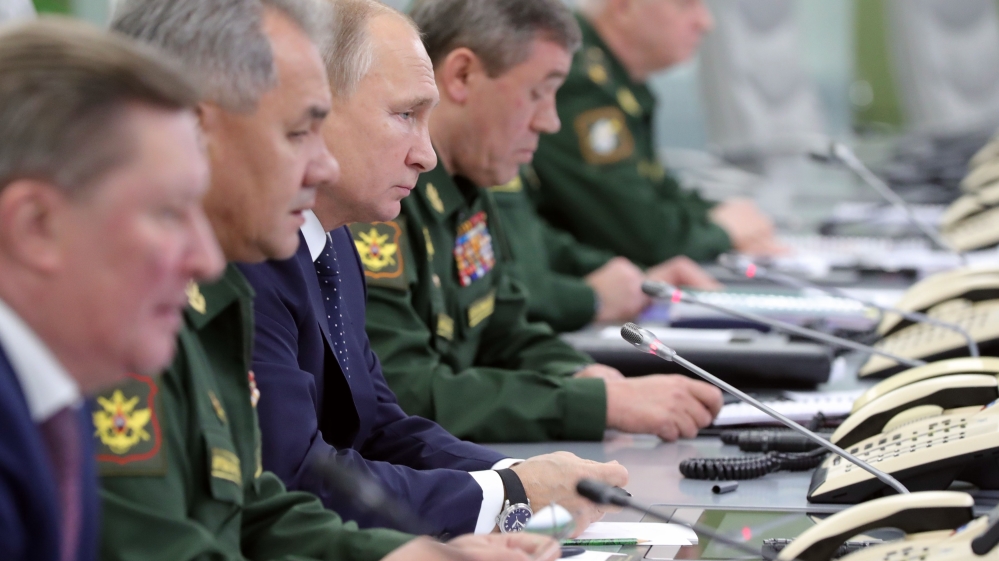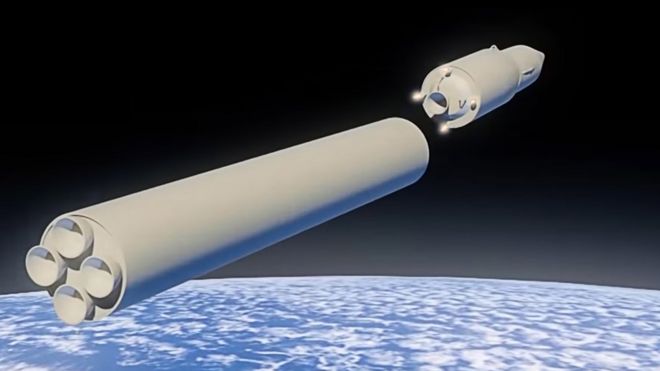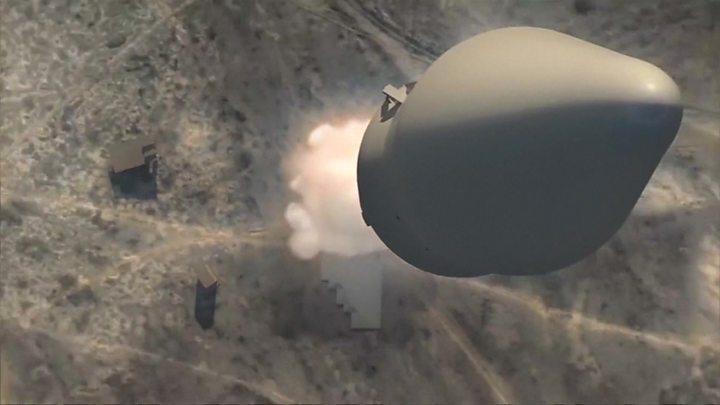Asfandyar Bhittani
PDF THINK TANK: ANALYST

- Joined
- Jan 2, 2017
- Messages
- 170
- Reaction score
- 6
- Country
- Location
Avangard: Russia deploys hypersonic nuclear-capable missiles
Following years of tests, first missile unit equipped with Avangard hypersonic glide vehicle enters combat duty.
4 hours ago

A handout still image from video footage made available in July 2018 by the Russian Defence Ministry shows the Avangard hypersonic strategic missile system equipped with a gliding hypersonic maneuvering warhead [Russian Defence Ministry Press Service/EPA]
MORE ON RUSSIA
Defence Minister Sergei Shoigu informed Putin that the first missile unit equipped with the Avangard hypersonic glide vehicle entered combat duty, the Defence Ministry said.
More:
The military has said that the Avangard is capable of flying 27 times faster than the speed of sound.
"I congratulate you on this landmark event for the military and the entire nation," Shoigu said during a conference call with top military officials.
The Strategic Missile Forces chief, General Sergei Karakayev, said during the call that the Avangard was put on duty with a unit in the Orenburg region in the southern Ural Mountains.
Putin unveiled the Avangard among other prospective weapons systems in his state-of-the-nation address in March 2018, noting that its ability to make sharp manoeuvres on its way to a target will render missile defence useless.
"It heads to target like a meteorite, like a fireball," he said then.
Putin described the Avangard's creation as a technological breakthrough comparable to the 1957 Soviet launch of the first satellite.
The Russian leader noted that Avangard is designed using new composite materials to withstand temperatures of up to 2,000 Celsius (3,632 Fahrenheit) resulting from a flight through the atmosphere at hypersonic speeds.
The new Russian weapon and a similar system being developed by China have troubled the United States, which has pondered defence strategies.

Russian Defence Minister Sergei Shoigu, second left, Russian President Vladimir Putin, third left, and Head of the Russian Armed Forces General Staff, First Deputy Defence Minister, Army General Valery Gerasimov, fourth left, visit the National Defense Management Center in Moscow, Russia in December 2018 [Michael Klimentyev/Kremlin Pool/Sputnik/EPA]
Putin has charged that Russia had to develop the Avangard and other prospective weapons systems because of the US efforts to develop a missile defence system that he claimed could erode Russia's nuclear deterrent.
Moscow has scoffed at the US claims that its missile shield is not intended to counter Russia's massive missile arsenals.
Earlier this week, Putin emphasised that Russia is the only country armed with hypersonic weapons. He noted that for the first time in history, Russia is now leading the world in developing an entirely new class of weapons, unlike in the past when it was catching up with the US.
In December 2018, the Avangard was launched from the Dombarovskiy missile base in the southern Urals and successfully hit a practice target on the Kura shooting range on Kamchatka, 6,000 kilometres (3,700 miles) away.
Russian media reports indicated that the Avangard will first be mounted on Soviet-built RS-18B intercontinental ballistic missiles, code-named SS-19 by NATO.
It is expected to be fitted to the prospective Sarmat heavy intercontinental ballistic missile after it becomes operational.
The Defence Ministry said last month that it demonstrated the Avangard to a team of US inspectors as part of transparency measures under the New Start nuclear arms treaty with the US.
The US has mulled new defence strategies to counter Russian and Chinese hypersonic weapons.
US officials have talked about putting a layer of sensors in space to more quickly detect enemy missiles, particularly the hypersonic weapons. The administration also plans to study the idea of basing interceptors in space, so the US can strike incoming enemy missiles during the first minutes of flight when the booster engines are still burning.
The Pentagon also has been working on the development of hypersonic weapons in recent years, and defence secretary Mark Esper said in August that he believes "it's probably a matter of a couple of years" before the US has one.
He has called it a priority as the military works to develop new long-range fire capabilities.
https://www.aljazeera.com/news/2019...nental-hypersonic-weapon-191227142922561.html
Russia deploys Avangard hypersonic missile system (BBC)
 Image copyrightGETTY IMAGES
Image copyrightGETTY IMAGES
Image captionA still from the defence ministry video shows an Avangard warhead (computer simulation)
Russia's first regiment of Avangard hypersonic missiles has been put into service, the defence ministry says.
The location was not given, although officials had earlier indicated they would be deployed in the Urals.
President Vladimir Putin has said the nuclear-capable missiles can travel more than 20 times the speed of sound and put Russia ahead of other nations.
They have a "glide system" that affords great manoeuvrability and could make them impossible to defend against.
Defence Minister Sergei Shoigu confirmed the "Avangard hypersonic glide vehicle entered service at 10:00 Moscow time on 27 December", calling it a "landmark event".
The West and other nations were "playing catch-up with us", he said.

It is hard to determine if Russia's new Avangard hypersonic missile system really has entered service, as Moscow claims, or if this is just an advanced phase of field testing. But President Putin's eagerness to claim bragging rights is to some extent justified. Russia looks to be ahead in the hypersonic stakes. China is also developing such systems; while the US appears to be somewhat behind.
Hypersonic missiles, as their name implies, fly very fast, at above Mach 5 - ie at least five times the speed of sound. Hypersonic weapons can take various forms. They can be cruise-type missiles, powered throughout their flight. Or, they can be carried aloft on board a ballistic missile from which the hypersonic "glide vehicle" separates and then flies to its target.
Such "boost-glide" systems, as they are known (Avangard appears to be one of these), are launched like a traditional ballistic missile, but instead of following an arc high above the atmosphere, the re-entry vehicle is put on a trajectory that allows it to enter Earth's atmosphere quite quickly, before gliding, un-powered, for hundreds or thousands of kilometres.

Media captionRussia released footage of two hypersonic systems in July 2018 - but was also concerned about a suspected leak of secrets
It is not so much the speed of the hypersonic weapon alone that counts. It is its extraordinary manoeuvrability as it glides towards its target. This poses a huge problem for existing anti-missile defence systems. Indeed the glide vehicle's trajectory, "surfing along the edge of the atmosphere" as one expert put it to me recently, presents any defensive system with additional problems. Thus, if Russia's claims are true, it has developed a long-range intercontinental missile system that may well be impossible to defend against.
The announcement that Avangard is operational heralds a new and dangerous era in the nuclear arms race. It confirms once again President Putin's focus on bolstering and modernising Russia's nuclear arsenal. It's indicative of the return of great power competition. Some analysts might well see Russia's development programme as a long-term strategy to cope with Washington's abiding interest in anti-missile defences. The US argument that these are purely designed to counter missiles from "rogue-states" like Iran or North Korea has carried little weight in Moscow.
This all comes at a time when the whole network of arms control agreements inherited from the Cold War is collapsing. One crucial treaty - the New START agreement - is due to expire in February 2021. Russia seems willing to extend the agreement but the Trump administration has so far appeared sceptical. With a whole new generation of nuclear weapons at the threshold of entering service, many believe not just that existing agreements should be bolstered, but that new treaties are needed to manage what could turn into a new nuclear arms race.
Source
Following years of tests, first missile unit equipped with Avangard hypersonic glide vehicle enters combat duty.
4 hours ago

A handout still image from video footage made available in July 2018 by the Russian Defence Ministry shows the Avangard hypersonic strategic missile system equipped with a gliding hypersonic maneuvering warhead [Russian Defence Ministry Press Service/EPA]
MORE ON RUSSIA
- Russia contests ban from major sporting events over dopingtoday
- Moscow police raid Russian opposition leader Navalny's officeyesterday
- Is Vladimir Putin creating a new reality on the ground in Crimea?3 days ago
- Can Russia's internet survive being shut out of world wide web?3 days ago
Defence Minister Sergei Shoigu informed Putin that the first missile unit equipped with the Avangard hypersonic glide vehicle entered combat duty, the Defence Ministry said.
More:
The military has said that the Avangard is capable of flying 27 times faster than the speed of sound.
"I congratulate you on this landmark event for the military and the entire nation," Shoigu said during a conference call with top military officials.
The Strategic Missile Forces chief, General Sergei Karakayev, said during the call that the Avangard was put on duty with a unit in the Orenburg region in the southern Ural Mountains.
Putin unveiled the Avangard among other prospective weapons systems in his state-of-the-nation address in March 2018, noting that its ability to make sharp manoeuvres on its way to a target will render missile defence useless.
"It heads to target like a meteorite, like a fireball," he said then.
Putin described the Avangard's creation as a technological breakthrough comparable to the 1957 Soviet launch of the first satellite.
The Russian leader noted that Avangard is designed using new composite materials to withstand temperatures of up to 2,000 Celsius (3,632 Fahrenheit) resulting from a flight through the atmosphere at hypersonic speeds.
The new Russian weapon and a similar system being developed by China have troubled the United States, which has pondered defence strategies.

Russian Defence Minister Sergei Shoigu, second left, Russian President Vladimir Putin, third left, and Head of the Russian Armed Forces General Staff, First Deputy Defence Minister, Army General Valery Gerasimov, fourth left, visit the National Defense Management Center in Moscow, Russia in December 2018 [Michael Klimentyev/Kremlin Pool/Sputnik/EPA]
Putin has charged that Russia had to develop the Avangard and other prospective weapons systems because of the US efforts to develop a missile defence system that he claimed could erode Russia's nuclear deterrent.
Moscow has scoffed at the US claims that its missile shield is not intended to counter Russia's massive missile arsenals.
Earlier this week, Putin emphasised that Russia is the only country armed with hypersonic weapons. He noted that for the first time in history, Russia is now leading the world in developing an entirely new class of weapons, unlike in the past when it was catching up with the US.
In December 2018, the Avangard was launched from the Dombarovskiy missile base in the southern Urals and successfully hit a practice target on the Kura shooting range on Kamchatka, 6,000 kilometres (3,700 miles) away.
Russian media reports indicated that the Avangard will first be mounted on Soviet-built RS-18B intercontinental ballistic missiles, code-named SS-19 by NATO.
It is expected to be fitted to the prospective Sarmat heavy intercontinental ballistic missile after it becomes operational.
The Defence Ministry said last month that it demonstrated the Avangard to a team of US inspectors as part of transparency measures under the New Start nuclear arms treaty with the US.
The US has mulled new defence strategies to counter Russian and Chinese hypersonic weapons.
US officials have talked about putting a layer of sensors in space to more quickly detect enemy missiles, particularly the hypersonic weapons. The administration also plans to study the idea of basing interceptors in space, so the US can strike incoming enemy missiles during the first minutes of flight when the booster engines are still burning.
The Pentagon also has been working on the development of hypersonic weapons in recent years, and defence secretary Mark Esper said in August that he believes "it's probably a matter of a couple of years" before the US has one.
He has called it a priority as the military works to develop new long-range fire capabilities.
https://www.aljazeera.com/news/2019...nental-hypersonic-weapon-191227142922561.html
Russia deploys Avangard hypersonic missile system (BBC)

Image captionA still from the defence ministry video shows an Avangard warhead (computer simulation)
Russia's first regiment of Avangard hypersonic missiles has been put into service, the defence ministry says.
The location was not given, although officials had earlier indicated they would be deployed in the Urals.
President Vladimir Putin has said the nuclear-capable missiles can travel more than 20 times the speed of sound and put Russia ahead of other nations.
They have a "glide system" that affords great manoeuvrability and could make them impossible to defend against.
Defence Minister Sergei Shoigu confirmed the "Avangard hypersonic glide vehicle entered service at 10:00 Moscow time on 27 December", calling it a "landmark event".
- Rocket mystery: What weapon was Russia testing in Arctic?
- INF nuclear treaty: Russia follows US in suspending pact
The West and other nations were "playing catch-up with us", he said.

It is hard to determine if Russia's new Avangard hypersonic missile system really has entered service, as Moscow claims, or if this is just an advanced phase of field testing. But President Putin's eagerness to claim bragging rights is to some extent justified. Russia looks to be ahead in the hypersonic stakes. China is also developing such systems; while the US appears to be somewhat behind.
Hypersonic missiles, as their name implies, fly very fast, at above Mach 5 - ie at least five times the speed of sound. Hypersonic weapons can take various forms. They can be cruise-type missiles, powered throughout their flight. Or, they can be carried aloft on board a ballistic missile from which the hypersonic "glide vehicle" separates and then flies to its target.
Such "boost-glide" systems, as they are known (Avangard appears to be one of these), are launched like a traditional ballistic missile, but instead of following an arc high above the atmosphere, the re-entry vehicle is put on a trajectory that allows it to enter Earth's atmosphere quite quickly, before gliding, un-powered, for hundreds or thousands of kilometres.

Media captionRussia released footage of two hypersonic systems in July 2018 - but was also concerned about a suspected leak of secrets
It is not so much the speed of the hypersonic weapon alone that counts. It is its extraordinary manoeuvrability as it glides towards its target. This poses a huge problem for existing anti-missile defence systems. Indeed the glide vehicle's trajectory, "surfing along the edge of the atmosphere" as one expert put it to me recently, presents any defensive system with additional problems. Thus, if Russia's claims are true, it has developed a long-range intercontinental missile system that may well be impossible to defend against.
The announcement that Avangard is operational heralds a new and dangerous era in the nuclear arms race. It confirms once again President Putin's focus on bolstering and modernising Russia's nuclear arsenal. It's indicative of the return of great power competition. Some analysts might well see Russia's development programme as a long-term strategy to cope with Washington's abiding interest in anti-missile defences. The US argument that these are purely designed to counter missiles from "rogue-states" like Iran or North Korea has carried little weight in Moscow.
This all comes at a time when the whole network of arms control agreements inherited from the Cold War is collapsing. One crucial treaty - the New START agreement - is due to expire in February 2021. Russia seems willing to extend the agreement but the Trump administration has so far appeared sceptical. With a whole new generation of nuclear weapons at the threshold of entering service, many believe not just that existing agreements should be bolstered, but that new treaties are needed to manage what could turn into a new nuclear arms race.
Source




